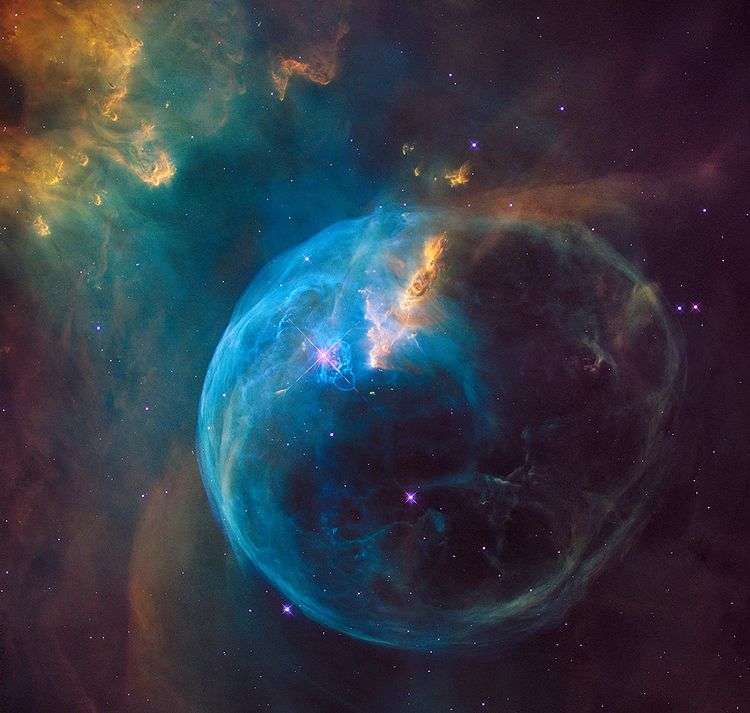NGC 7635
| Emission nebula | |
|---|---|
| H II region | |
 Widefield image of NGC 7635 as captured by the Hubble telescope. | |
| Observation data: J2000 epoch | |
| Right ascension | 23h 20m 48.3s[1] |
| Declination | +61° 12′ 06″[1] |
| Distance | 7100[2] to 11000[3][4] ly (3,400 pc) |
| Apparent magnitude (V) | ~10[5] |
| Apparent dimensions (V) | 15′ × 8′[6] |
| Constellation | Cassiopeia |
| Physical characteristics | |
| Radius | 3[2] to 5[7][4] ly |
| Notable features | Shell around SAO 20575[1] |
| Designations |
Bubble Nebula[1] Sharpless 162 (Sh2-162) Caldwell 11 |
NGC 7635, also called the Bubble Nebula, Sharpless 162, or Caldwell 11, is a H II region[1] emission nebula in the constellation Cassiopeia. It lies close to the direction of the open cluster Messier 52. The "bubble" is created by the stellar wind from a massive hot, 8.7[1] magnitude young central star, the 15 ± 5 M☉[4] SAO 20575 (BD+60 2522).[7] The nebula is near a giant molecular cloud which contains the expansion of the bubble nebula while itself being excited by the hot central star, causing it to glow.[7] It was discovered in 1787 by William Herschel.[5] The star SAO 20575 or BD+602522 is thought to have a mass of 10-40 Solar masses.
Amateur observation
With an 8 or 10-inch (250 mm) telescope, the nebula is visible as an extremely faint and large shell around the star.[6][1] The nearby 7th magnitude star on the west hinders observation, but one can view the nebula using averted vision.[6] Using a 16 to 18-inch (460 mm) scope, one can see that the faint nebula is irregular, being elongated in the north south direction.[6]
Notes
References
- SIMBAD (February 23, 2007). "Results for NGC 7635". SIMBAD, Centre de Données Astronomiques de Strasbourg.
- Kepple, George Robert; Sanner, Glen W. (1998). The Night Sky Observer's Guide. 1. Willmann-Bell, Inc. pp. 108–109. ISBN 0-943396-58-1.
- HubbleSite (2000). "An Expanding Bubble in Space".
- Nemiroff, R.; Bonnell, J., eds. (July 16, 2004). "The Bubble". Astronomy Picture of the Day. NASA.
- Nemiroff, R.; Bonnell, J., eds. (November 7, 2005). "NGC 7635: The Bubble Nebula". Astronomy Picture of the Day. NASA.
- Nemiroff, R.; Bonnell, J., eds. (October 18, 2006). "NGC 7635: The Bubble". Astronomy Picture of the Day. NASA.
- Nemiroff, R.; Bonnell, J., eds. (November 23, 2016). "NGC 7635: Bubble in a Cosmic Sea". Astronomy Picture of the Day. NASA.
| url= http://apod.nasa.gov/apod/ap161123.html
External links
- NGC7635 The Bubble Nebula
- NGC 7635 on WikiSky: DSS2, SDSS, GALEX, IRAS, Hydrogen α, X-Ray, Astrophoto, Sky Map, Articles and images
- Bubble Nebula at Constellation Guide